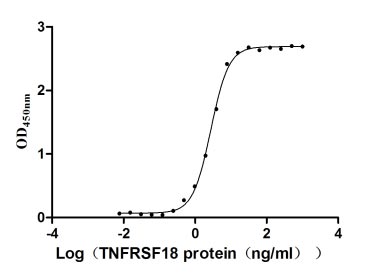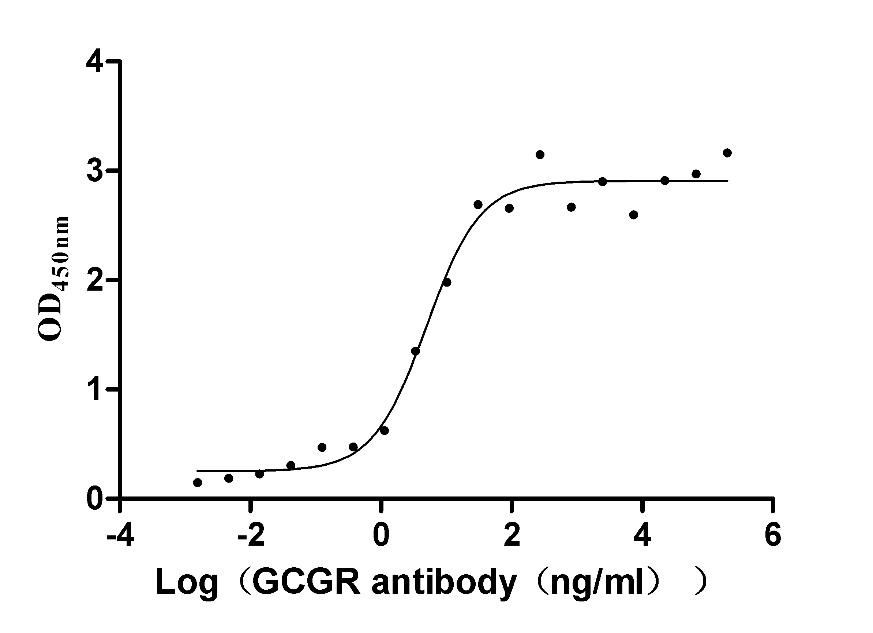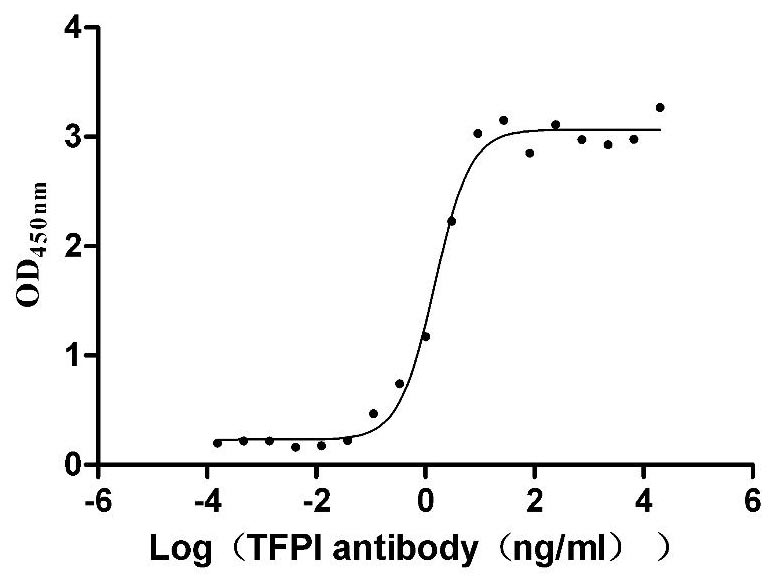Recombinant Rat Caveolin-3 (Cav3)
-
中文名称:Recombinant Rat Caveolin-3(Cav3),Yeast
-
货号:CSB-YP004573RA
-
规格:
-
来源:Yeast
-
其他:
-
中文名称:Recombinant Rat Caveolin-3(Cav3),Yeast
-
货号:CSB-EP004573RA
-
规格:
-
来源:E.coli
-
其他:
-
中文名称:Recombinant Rat Caveolin-3(Cav3),Yeast
-
货号:CSB-EP004573RA-B
-
规格:
-
来源:E.coli
-
共轭:Avi-tag Biotinylated
E. coli biotin ligase (BirA) is highly specific in covalently attaching biotin to the 15 amino acid AviTag peptide. This recombinant protein was biotinylated in vivo by AviTag-BirA technology, which method is BriA catalyzes amide linkage between the biotin and the specific lysine of the AviTag.
-
其他:
-
中文名称:Recombinant Rat Caveolin-3(Cav3),Yeast
-
货号:CSB-BP004573RA
-
规格:
-
来源:Baculovirus
-
其他:
-
中文名称:Recombinant Rat Caveolin-3(Cav3),Yeast
-
货号:CSB-MP004573RA
-
规格:
-
来源:Mammalian cell
-
其他:
产品详情
-
纯度:>85% (SDS-PAGE)
-
基因名:
-
Uniprot No.:
-
别名:Cav3Caveolin-3
-
种属:Rattus norvegicus (Rat)
-
蛋白长度:Full length protein
-
表达区域:1-151
-
氨基酸序列MMTEEHTDLE ARIIKDIHCK EIDLVNRDPK NINEDIVKVD FEDVIAEPEG TYSFDGVWRV SYTTFTVSKY WCYRLLSTLL GVPLALLWGF LFACISFCHI WAVVPCIKSY LIEIQCISHI YSLCIRTFCN PLFAALGQVC SNIKVVLRRE G
-
蛋白标签:Tag type will be determined during the manufacturing process.
The tag type will be determined during production process. If you have specified tag type, please tell us and we will develop the specified tag preferentially. -
产品提供形式:Lyophilized powder
Note: We will preferentially ship the format that we have in stock, however, if you have any special requirement for the format, please remark your requirement when placing the order, we will prepare according to your demand. -
复溶:We recommend that this vial be briefly centrifuged prior to opening to bring the contents to the bottom. Please reconstitute protein in deionized sterile water to a concentration of 0.1-1.0 mg/mL.We recommend to add 5-50% of glycerol (final concentration) and aliquot for long-term storage at -20℃/-80℃. Our default final concentration of glycerol is 50%. Customers could use it as reference.
-
储存条件:Store at -20°C/-80°C upon receipt, aliquoting is necessary for mutiple use. Avoid repeated freeze-thaw cycles.
-
保质期:The shelf life is related to many factors, storage state, buffer ingredients, storage temperature and the stability of the protein itself.
Generally, the shelf life of liquid form is 6 months at -20°C/-80°C. The shelf life of lyophilized form is 12 months at -20°C/-80°C. -
货期:Delivery time may differ from different purchasing way or location, please kindly consult your local distributors for specific delivery time.Note: All of our proteins are default shipped with normal blue ice packs, if you request to ship with dry ice, please communicate with us in advance and extra fees will be charged.
-
注意事项:Repeated freezing and thawing is not recommended. Store working aliquots at 4°C for up to one week.
-
Datasheet :Please contact us to get it.
靶点详情
-
功能:May act as a scaffolding protein within caveolar membranes. Interacts directly with G-protein alpha subunits and can functionally regulate their activity. May also regulate voltage-gated potassium channels. Plays a role in the sarcolemma repair mechanism of both skeletal muscle and cardiomyocytes that permits rapid resealing of membranes disrupted by mechanical stress. Mediates the recruitment of CAVIN2 and CAVIN3 proteins to the caveolae.
-
基因功能参考文献:
- Cav3 depletion in cardiac fibroblasts induced an increase in collagen content, cell proliferation, and phenotypic conversion of fibroblasts to myofibroblasts. Conversely, Cav3 overexpression in cardiac fibroblasts was shown to inhibit angiotensin II-mediated excessive collagen deposition through protein kinase C-epsilon inactivation. PMID: 29486470
- Antioxidant N-acetylcysteine attenuated myocardial dysfunction and myocardial I/R injury by improving Cav-3/eNOS signaling. PMID: 27733157
- Hypoxic preconditioning promotes the translocation of protein kinase C epsilon binding with caveolin-3 at cell membrane, not at mitochondrial one, in rat heart. PMID: 26313243
- miR-22 down-regulated Cav3, leading to restored eNOS activity/NO production, which inhibited cardiac myocyte apoptosis and promoted cardiac function after myocardial ischemia and reperfusion. PMID: 26191152
- MURC/cavin-4 requires its coiled-coil domain to target the plasma membrane and to stabilize Cav3 at the plasma membrane of cardiomyocytes PMID: 26497963
- HLP forms a triple complex with RyR2 and caveolin-3. siRNA and adenovirus-mediated KD of HLP decreased the electrically evoked Ca(2+) release from the sarcoplasmic reticulum PMID: 26071359
- PKCbeta2 inhibition protects diabetic hearts from myocardial ischemia/reperfusion injury through Cav-3-dependent activation of Akt. PMID: 25849791
- statin treatment can reduce caveolin 3 expression, with functional consequences consistent with the known role of caveolae in the cardiac cell. PMID: 25211146
- Cav-3 plays an important role in the stimulation of calcium signaling by PKA-induced phosphorylation at the t-tubules. PMID: 24412535
- Hormonal alteration causes a significant change in the expression of caveolin 2 and 3 in smooth muscle of rat urinary bladder. PMID: 24040945
- Expression of caveolin-3 siRNA stimulated angiotensinogen expression in cardiac myocytes. PMID: 23058350
- Data indicate that Gja1, Cav3 and Kcnk3 were up-regulated and Hcn2 was down-regulated in hearts of exercise trained Goto-Kakizaki (GK) type 2 diabetic rat compared to sedentary GK controls. PMID: 23620341
- hERG expression in the plasma membrane is regulated by Cav3 via Nedd4-2 PMID: 22879586
- caveolin-3 protein expression and immunoreactivity were reduced in bladder smooth muscle at 6, 12 and 19 months of age compared with young animals. PMID: 22374691
- Estrogen attenuates the hypertrophic response induced by pressure overload through down-regulation of extracellular signal-regulated kinases 1/2 phosphorylation and up-regulation of caveolin-3 expression. PMID: 21170593
- investigation of mechanisms in matricine signaling: up-regulation of Cav3 plays a role in extracellular matrix (i.e., laminin) stimulation of pituitary folliculostellate cell proliferation PMID: 21508095
- Caveolin-3 plays an important role in the mechanism by which 17 beta-estadiol attenuates diet-induced glucose intolerance. PMID: 20953984
- Depletion of Cav3 induced by delivery of the dominant-negative Cav3 (P104L) form impairs myoblast differentiation via Akt and p38 signalling networks, leading to an immature cell and molecular signature. PMID: 21182936
- association between VDR and caveolin-3 and the regulation of this interaction by 1,25(OH)2D3 are fundamentally important in understanding 1,25(OH)2D3 signal transduction in heart cells PMID: 20304057
- Suggest that caveolin is an important regulator of glucose metabolism that can enhance insulin signals and improve glucose metabolism in diabetic mice. PMID: 19923424
- Cardiac caveolin-3 is identified as juxtamembrane scaffolding for estrogen receptor alpha docking at caveolae, which provide a unique compartment for conveying 17beta-estradiol-elicited, rapid signaling to regulate connexin43 phosphorylation. PMID: 19523531
- detected by Western blot analysis and immunofluorescence microscopy of isolated sinus endothelial cells and tissue cryosections of the spleen PMID: 11904769
- estradiol reduces the association of cardiac eNOS with the inhibitory protein caveolin-3 PMID: 12003841
- caveolin-3-caveolin-2 interactions may play a role in caveolae biogenesis and influence cardiac muscle physiology PMID: 12649076
- Expression of caveolin-3 in aortic vascular smooth muscle cells is determined by the state of cell differentiation. PMID: 12705878
- Cav-3 protein expression is increased in the failing myocardium. NOS1, confined to the sarcolemma, interacts with Cav-3. Increased Cav-3-associated NOS1 could constitute an increased pool of enzyme available for activation on stimulation. PMID: 15466641
- Caveolin-3 is expressed constitutively in some astrocytes, but not in endothelial cells; its immunoreactivity is increased in reactive astrocytes in experimental autoimmune encephalomyelitis lesions. PMID: 15925413
- The distribution of G-protein-coupled receptors (GPCR), G-proteins, and adenylate cyclase with caveolin-3 in sarcolemmal and intracellular regions suggests multiple Cav-3-localized microdomains for signaling by hormones and drugs in the heart. PMID: 15961389
- Caveolin-3 is adjacent to a group of extradyadic ryanodine receptors PMID: 15980179
- A redistribution of caveolin-3 in the light fractions of myocardium occurred after 10 min of reperfusion PMID: 16565301
- caveolin-3 is responsible for keeping endothelial nitric oxide synthase in a membrane compartment in the apical region of ciliated cells PMID: 17123860
- Suggest that Cav3 expression, which is closely related to added functional stimuli, reflects the differentiation of the type B synoviocytes. PMID: 18286598
- This study found that CAV-3 immunoreactivities (IRs) were Localized in the myelin sheath during peripheral nerve development. CAV-3 IRs were intense during the early postnatal stage, but decreased as the peripheral nerves matured at postnatal weeks 3-5. PMID: 18720574
- Confocal immunofluorescence microscopy shows that caveolin-3 is present throughout the t-tubule system in skeletal muscle fibers, with 'hot-spots' at the necks of the tubules in the sub-sarcolemmal space. PMID: 19101541
- Report colocalization of K(ATP) channel pore-forming subunit Kir6.2 and caveolin-3 along the cardiac myocyte plasma membrane. PMID: 19181933
显示更多
收起更多
-
亚细胞定位:Golgi apparatus membrane; Peripheral membrane protein. Cell membrane; Peripheral membrane protein. Membrane, caveola; Peripheral membrane protein. Cell membrane, sarcolemma.
-
蛋白家族:Caveolin family
-
组织特异性:Expressed predominantly in muscle.
-
数据库链接:
KEGG: rno:29161
STRING: 10116.ENSRNOP00000007601
UniGene: Rn.98191
Most popular with customers
-
Recombinant Human Tumor necrosis factor receptor superfamily member 18 (TNFRSF18), partial (Active)
Express system: Mammalian cell
Species: Homo sapiens (Human)
-
Recombinant Human Glucagon receptor (GCGR), partial (Active)
Express system: Mammalian cell
Species: Homo sapiens (Human)
-
Recombinant Human Poliovirus receptor (PVR) (I340M), partial (Active)
Express system: Mammalian cell
Species: Homo sapiens (Human)
-
Recombinant Human HLA class II histocompatibility antigen gamma chain (CD74), partial (Active)
Express system: Mammalian cell
Species: Homo sapiens (Human)
-
Recombinant Human B-lymphocyte antigen CD20 (MS4A1)-VLPs (Active)
Express system: Mammalian cell
Species: Homo sapiens (Human)
-
Recombinant Human Tissue factor pathway inhibitor (TFPI), partial (Active)
Express system: Mammalian cell
Species: Homo sapiens (Human)
-
Recombinant Human Claudin-9 (CLDN9)-VLPs (Active)
Express system: Mammalian cell
Species: Homo sapiens (Human)
-
Recombinant Macaca fascicularis CD44 antigen (CD44), partial (Active)
Express system: Mammalian cell
Species: Macaca fascicularis (Crab-eating macaque) (Cynomolgus monkey)




-AC1.jpg)
-AC1.jpg)














